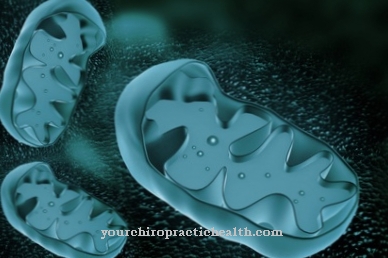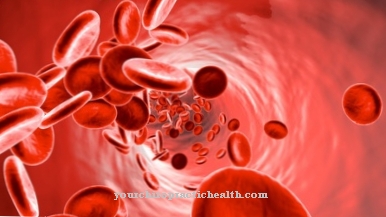Of the Patellar tendon reflex corresponds to the monosynaptic kneecap reflex and is triggered by pressure on the patellar tendon. The thigh muscles contract as part of the involuntary self-reflex movement and the lower leg shoots upwards. An exaggerated kneecap reflex is a pyramidal orbit sign.
What is the patellar tendon reflex?

Reflexes are involuntary and automated movement responses to a particular stimulus. As a rule, they have protective functions or support certain processes in human motor skills. They are either present from birth or acquired through life experience.
The patellar tendon reflex is a congenital leg reflex. The reflex movement is one of the self-reflexes. In this reflex, the stimulus reception and stimulus response take place in the same organ or muscle.
The patellar tendon reflex will also Hamstring reflex, Knee phenomenon, or Patellar reflex called. The designation as Quadriceps stretch reflex is also common. The reflex is only connected via a single synapse and therefore belongs to the monosynaptic reflexes.
The involuntary reflex movement is triggered by a blow on the so-called patellar tendon in the area of the kneecap. This tendon is the insertion tendon of the thigh muscles. The blow therefore causes the thigh extensor muscles (quadriceps femoris muscle) to contract, which causes the knee joint to stretch and the lower leg to snap upwards.
The femoral nerve acts as a mediator in the motor reflex response. In the central nervous system, the reflex is interconnected via the motor neurons in segment L3 and the neurons in neighboring segments L2 and L4.
The kneecap reflex is one of the most famous reflexes in the human body.
Function & task
The function and task of the kneecap reflex is originally functional and supportive. The connection enables people to walk upright on uneven floors, for example. If the patellar tendon is stimulated to stretch when jumping up, climbing stairs or stumbling, then thanks to the reflex response, the right muscles tense and prevent the person from falling over.
Without the reflex, people would lose their balance and fall during numerous movements. To prevent this from occurring, the speed of the automated stimulus response is crucial.
Like all motor reflexes, the kneecap reflex is controlled by the spinal cord. This interconnection guarantees a quick response and ensures that the reflex can actually serve its purpose and is not only triggered after falling.
The muscle spindles in the quadriceps perceive stretching and transmit it as receptor information to the spinal cord. The information from the stretch receptors is switched to motor efferent neurons in the lumbar segments via a synapse each.
The efferent neurons run through the lumbar plexus and return to the thigh muscle with the femoral nerve. A contraction is triggered.
The hamstring (biceps femoris muscle) is the antagonist of the thigh muscle. So that this counteracting muscle of the thigh muscles is not activated at the same time, an inhibiting mechanism sets in: the action potential of the leg extensors suppresses the potential of the hamstrings.
This inhibition mechanism is due to the branching of the axon, which directs the stimulus information to the spinal cord. This axon has a so-called divergence. One branch of this runs to the motor neurons that innervate the extensor muscles. The second branch to the inhibiting neurons of the leg extensor runs through another synapse.
You can find your medication here
➔ Medicines for paresthesia and circulatory disordersIllnesses & ailments
The kneecap reflex is particularly important for the reflex examination. The doctor prefers to trigger the monosynaptic reflex on the seated patient. The patient crosses one leg loosely over the other. The examiner also often lifts the leg at the hollow of the knee. The doctor gives the patellar tendon below the kneecap a pronounced blow with the reflex hammer. In the case of a lively reflex response, a little pressure on the fingers placed on the upper edge of the tendon is enough to trigger it.
The trigger is repeated by the doctor at intervals of two seconds. Then the second leg is also checked for the reflex. The results are then interpreted. If the reflex is gone, there is probably a lumbar disc herniation in segment L3. A peripheral nerve injury is also an option. If the reflex is only weakened, neuropathy is the most likely diagnosis.
An increased reflex or even a widened reflex zone is understood as a so-called pyramidal path sign. Like all other signs of the pyramidal trajectory, this phenomenon indicates damage to the motor neurons in the central nervous system in the pyramidal system. Such damage usually manifests itself either in muscle weakness, unsteadiness of gait and paralysis or in spasticity.
The causes of the damage can be, for example, inflammatory manifestations of multiple sclerosis or degenerative manifestations in the context of ALS. ALS in particular specifically attacks the motor nervous system.
In addition to an increased kneecap reflex, a number of pathological foot reflexes are also among the pyramidal trajectories. This reflex group is also known as the Babinski group and encompasses reflexes such as the Babinski and Chaddock reflex.
The neurological reflex test and examination for pathological reflexes is primarily used for differential diagnosis and the localization of nerve lesions in the central and peripheral nervous system. For example, the kneecap reflex usually remains unchanged in stroke patients. This usually applies even if there are signs of paralysis.



























